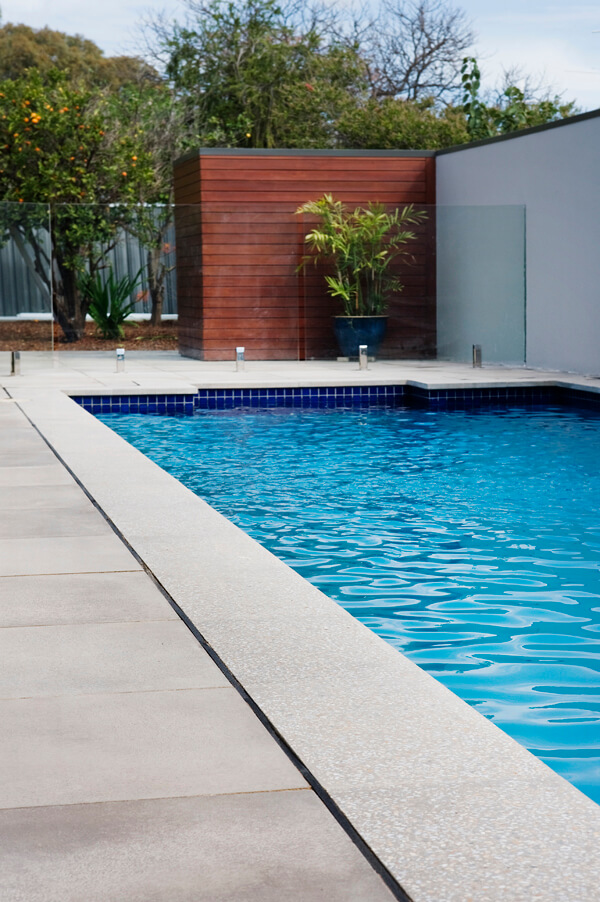CUSTOMSTONE SA FAQS
FREQUENTLY ASKED QUESTIONS
Are all concrete products suitable for use around a salt water pool?
Yes. Our products contain a sealer in the concrete mix which helps to protect them from salt water damage.
How do I choose a good paving or pool coping contractor to complete my job?
All contractors recommended by Customstone SA are skilled at dealing with wetcast products and have laid our pavers and pool coping in many of our projects before. It is very important to have an experienced contractor do your paving or pool coping job. Contractors who have not used wetcast products may not know how to treat them correctly.
Do your products stain?
Staining can occur because the products are made from concrete which is a porous product. It can be reduced if the substance causing the stain is cleaned up straight away and usually fades and disappears over a period of time. Sealing the pavers can also help reduce staining.
Do the pavers need sealing?
Sealing does help to protect the pavers from staining and efflorescence. However, it is imperative that the sealer be suitable for concrete products. We advise people to contact a professional sealing company to give advice about the best options for your project. They will also clean and seal the pavers for you.
What is efflorescence?
Efflorescence is a stain or a white film or marks which appear on a paver usually within a few weeks or months of installing. This is a natural occurrence which is usually more visible on darker colours. It often looks as though the pavers have faded but it does not affect the structural quality of the pavers.
What causes efflorescence?
Concrete products contain cement. As the cement hydrates, it produces lime or water-soluble salts, such as calcium hydroxide. This calcium hydroxide is water soluble and, therefore, migrates to the surface of the concrete pavers through capillary action.
When calcium hydroxide reaches the surface of the pavers, a chemical reaction occurs with the carbon dioxide present in air. As it reacts with carbon dioxide, the calcium hydroxide forms a water insoluble calcium carbonate, which creates the whitish haze on the surface of concrete pavers.
As the moisture evaporates off the surface of the pavers, the whitish haze becomes more pronounced.
It can be exacerbated by poor drainage, incorrect product used as a base or by wetting the pavers when they are still fresh.
What can be done to improve the appearance of pavers which have been affected by efflorescence?
Usually efflorescence disappears naturally within a year or so after pavers’ installation. The additive in the mix does help to control the problem but it cannot be completely eliminated.
Most contractors use a commercial efflorescence cleaner. Most cleaners will effectively reduce the whitish haze on the paver caused by efflorescence, but only if used properly. It is advisable to strictly follow the directions on the cleaner.
Can efflorescence be stopped if the pavers are cleaned?
Efflorescence can be cleaned from the pavers but will continue to reappear until the calcium hydroxide has time to exhaust itself. It may be necessary to apply the cleaner more than once.
Can wetmix pavers be treated the same way as any other pavers?
No. Wetmix products need to be treated carefully because they take longer to cure. Rough treatment such as stacking in a wheelbarrow can cause them to chip.
Can wetmix pavers be cross-hatched on top of other pavers?
No. Cross-hatching can lead to uneven drying & curing of the pavers underneath, resulting in a permanent colour difference where the paver on top was placed.
Can your pavers be laid tightly against each other?
No. The pavers need to have a gap between them to allow for movement. Pavers that are too tight will cause chipping, especially at the edges, and unevenness between pavers.
Similarly, at places where pavers are laid next to pool coping, an expansion joint is required to create space for movement.
Do concrete pavers fade?
Natural fading does occur and is especially noticeable in dark colours such as red and black. The additive used in the mix helps to protect the paver from fading as does the use of a good concrete products sealer.

